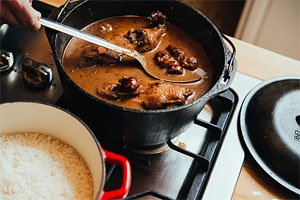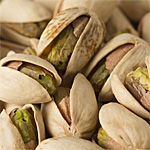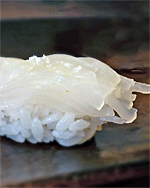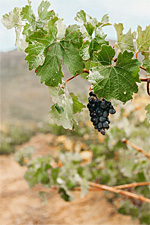Louisiana Gumbo
 Special to Road Trips for Foodies
Special to Road Trips for Foodies
By Lafayette Travel
Gumbo is what your momma made, a definition that assures that there are as many different types of gumbos as there are mothers who make them. Sometimes it’s caramel colored roux, okra, tomatoes, shrimp and crab seasoned delicately and thickened slightly to the viscosity of a soup. Sometimes it’s a chocolate brown roux, thick as a stew and brimming with lumps of chicken and sausage. Still others have no roux at all and are served entirely with greens and legumes. Gumbos are typically served over steamed white rice, but some tables prefer sweet potatoes or potato salad. The variation is maddening when trying to sort out what makes gumbo, gumbo.
Details about the origins of gumbo are murky. A dish called gumbo doesn’t really show up in historical record until the beginning of the 19th century, when the word starts showing up prolifically in correspondence. What it was isn’t exactly clear except that it most likely included okra, given that the name derives directly from the West African word for the gooey vegetable, kimgombo, and was served primarily with seafood. African slaves arrived in the port of New Orleans toting okra seeds and a rich culinary tradition that became profoundly influential on Creole foodways. Mingling with the rich variety of European and Native American food traditions that converged in New Orleans, gumbo emerged from the void a broth thickened with okra and served over starch, at that time a corn meal mush. This was the primordial gumbo.
Over the next 100 years, that soup-like substance evolved into what we moderns call gumbo. By 1885, La Cuisine Creole, one of the earliest published Creole cookbooks, documented several different recipes for gumbo (called gombo in the book), served over rice with a variety of proteins. Recipes for chicken and okra, oyster and okra, shrimp and okra, or just okra gumbos are included noting that they are “a most excellent form of soup” particularly well suited to re-using leftover meats and vegetables. Rice became the ubiquitous base when German and Acadian farmers across the state began cultivating the grain in commercial quantities in the late 19th century, making it a cheap and available starch statewide.
While gumbos speak different languages, they have a common root: roux, a thickener made of flour browned in oil. Roux in general is credited to Louisiana’s French heritage, though others have suggested that the browning of starches comes from Native American cooking techniques. Louisiana tribes like Choctaws and Houmas were known to brown corn meal to add flavor and preserve them. French-influenced communities such as colonial African slaves and Acadian exiles would have been familiar with the technique via browned butters and bechamel in French cooking, and adopted it to their needs.
Like everything else in a gumbo, how dark your roux gets depends on where you live. Closer to New Orleans, roux tends toward lighter shades, looking at its darkest like light caramel. The further west you go, a dark roux can trick the uninitiated into believing it’s a pan of simmering chocolate ganache, a mistake often made by sweet- toothed kids around Christmas. The exact reason for the variance is unclear, though best guesses are that roux colors change to accommodate different proteins: lighter roux for delicate meats like seafood and darker roux for gamier fare like poultry or sausage. Once the roux is in the stock, however, gumbos of different shades and flavors blossom across the bayous.
Taking in the variety, it becomes readily clear that gumbo is not so much a singular dish. According to folklorist John Laudun, “gumbo is not a word, it’s a syntax, a way of putting something together.” It reveals a concentric rather than linear evolution of the food, bubbling from identical cultural stews scattered throughout southern Louisiana. Germans, French, Spaniards, Italians, Africans, and Native Americans fell into cultural exchange throughout the state. Thus, the same kinds of influences abound across the various parish lines, and are responsible for simultaneous innovation in a Louisiana national dish that is more exceptions than rules. Citizens of Vermillion Parish and St. Mary Parish in south Acadiana are just as likely to include seafood in their gumbos as the Creoles of New Orleans. Some parts of northern Acadiana include sweet potatoes, while garlic makes its way into pots along the Bayou Teche where Italian heritage is prominent. Eggs are sometimes thrown to the mix to add protein to shrimp gumbos on a stretched budget, soaking up the briny shrimp flavors. It’s a heterogeneous landscape.
Gumbo is not one thing. But its definition is nevertheless apparent. For something to truly be gumbo it must participate in the unique Louisiana culinary heritage of Cajuns, Creoles, Spaniards, Germans, Italians, Irish, Choctaws, Coushattas, Houmas, and all kinds of other peoples, places and things. It more often than not will have a roux, which will come in varying volumes, shades, and tastes. It will be served with a spoonful or cupful of rice, or thickened with okra or file’, or enriched by poultry marrow and andouille smoke. It may come from New Orleans, but it’s at home in Lafayette, Louisiana. And no matter how your mother made hers, you will know a gumbo when you see it.
(Photo courtesy of Lafayette Travel)

















